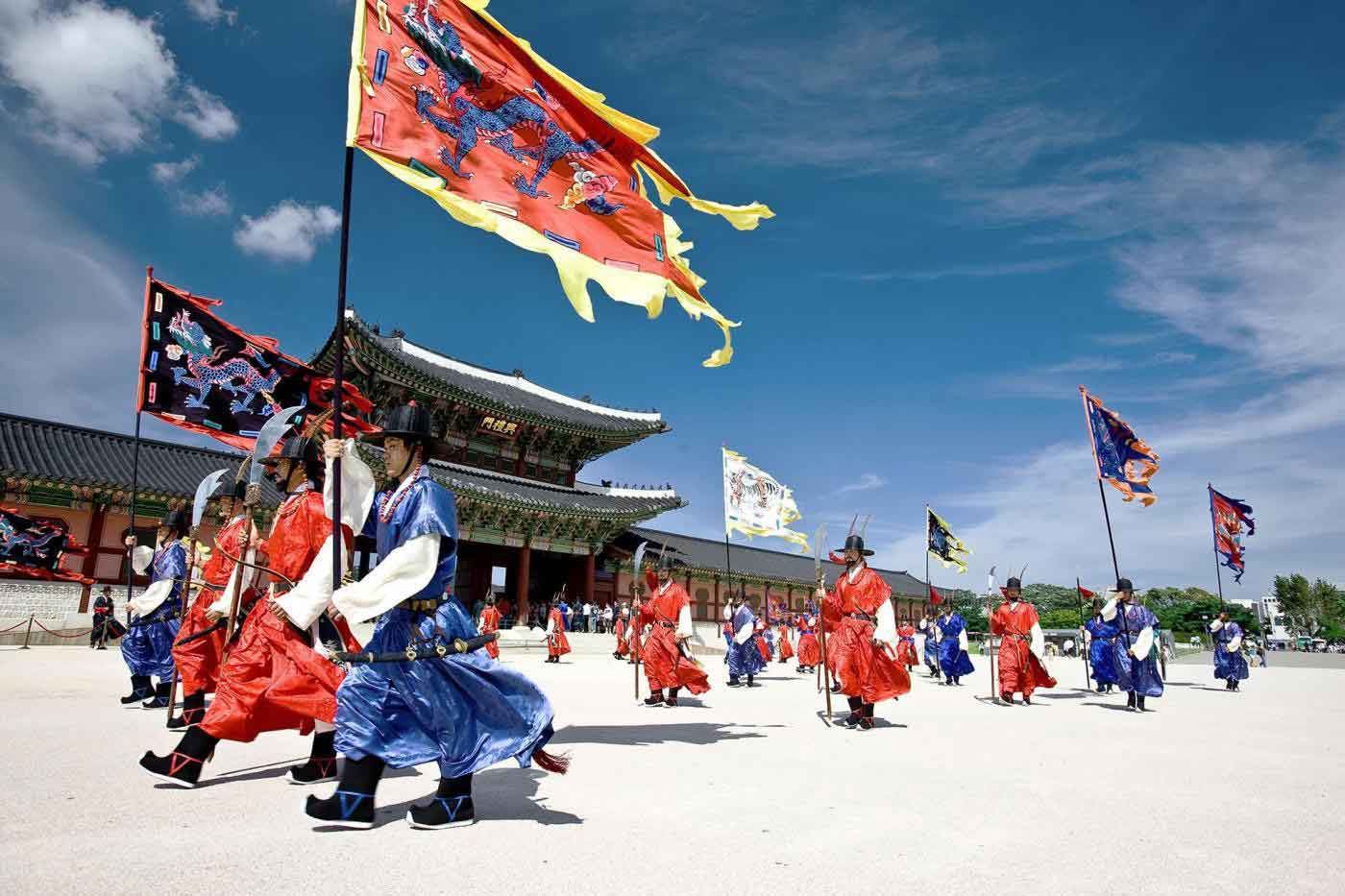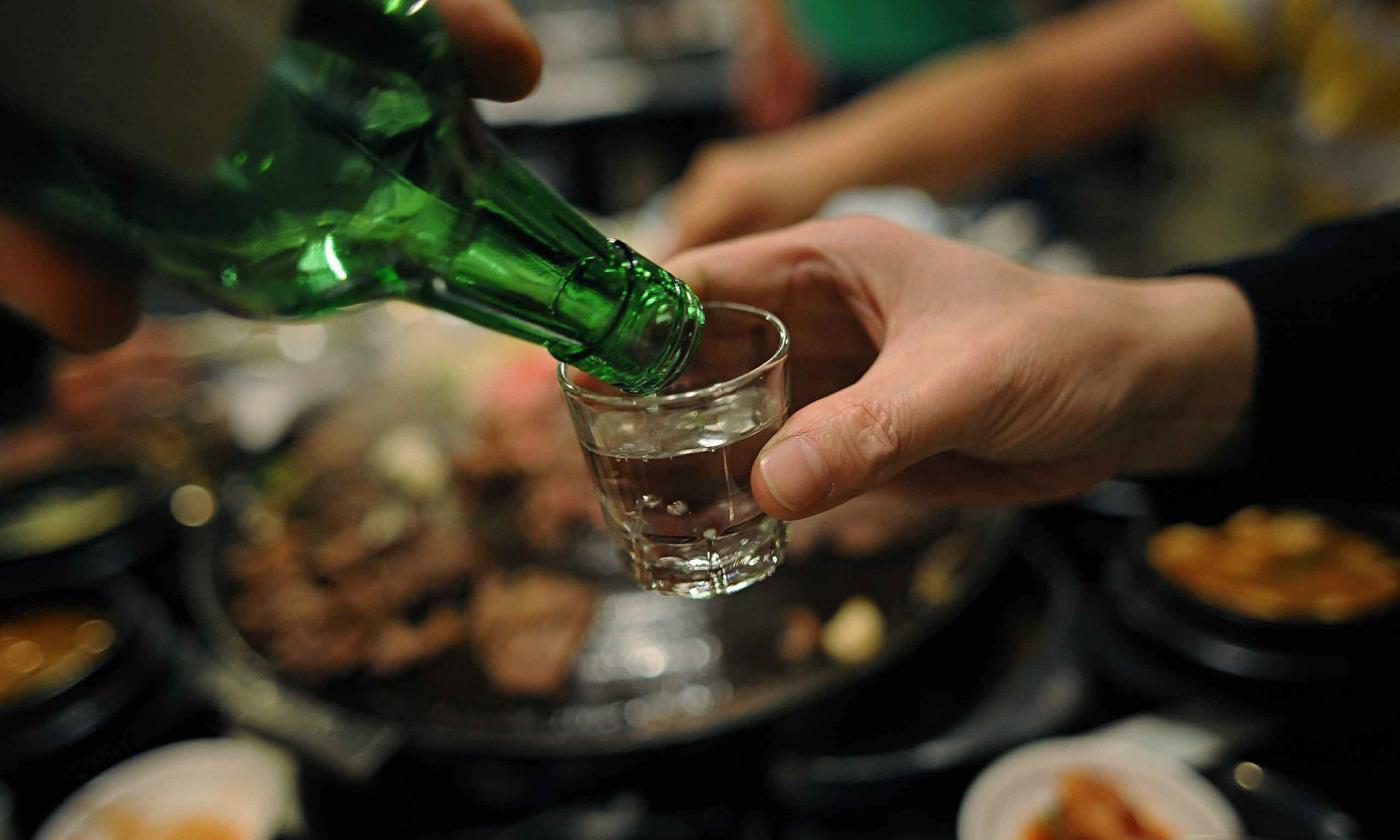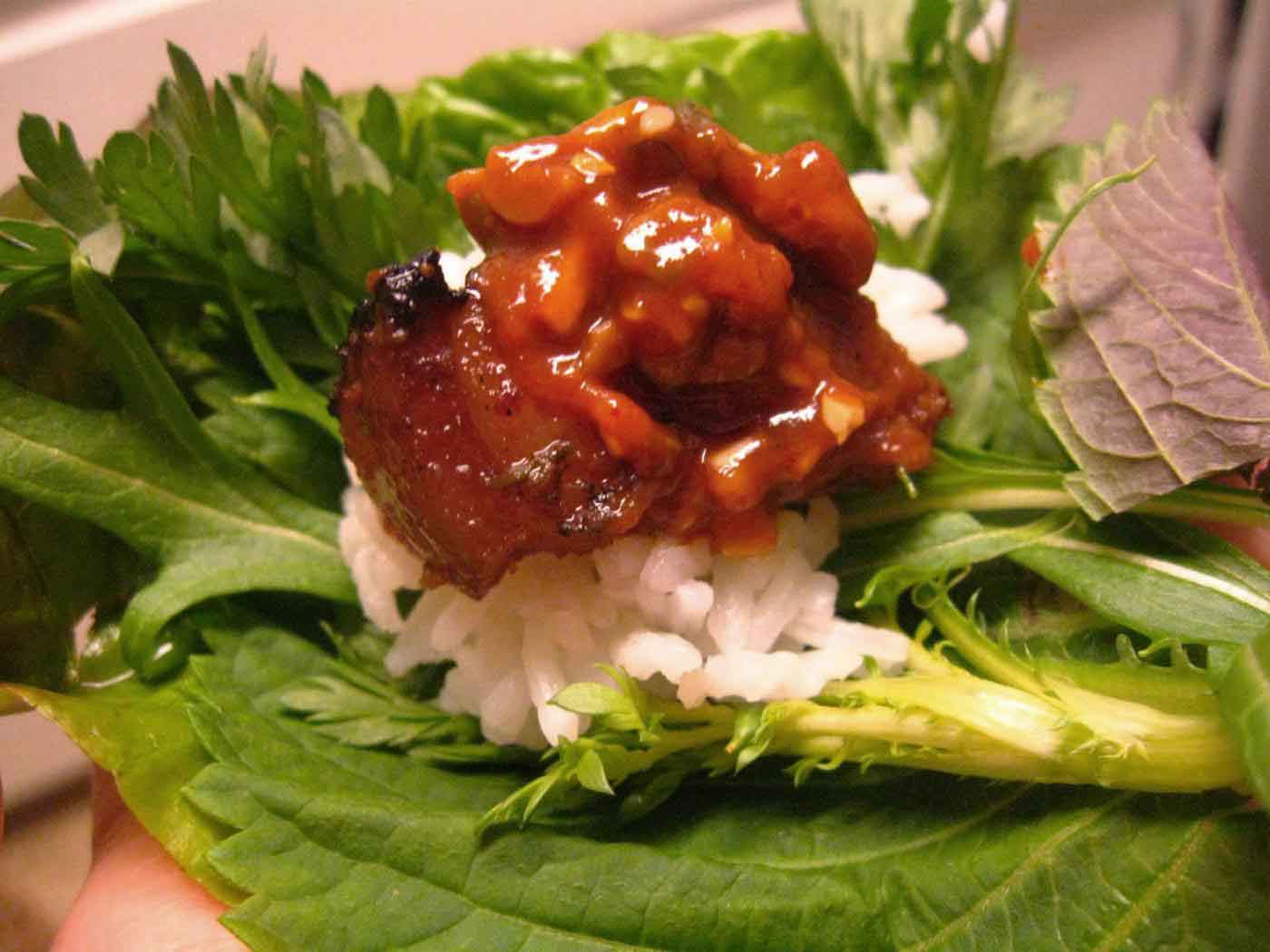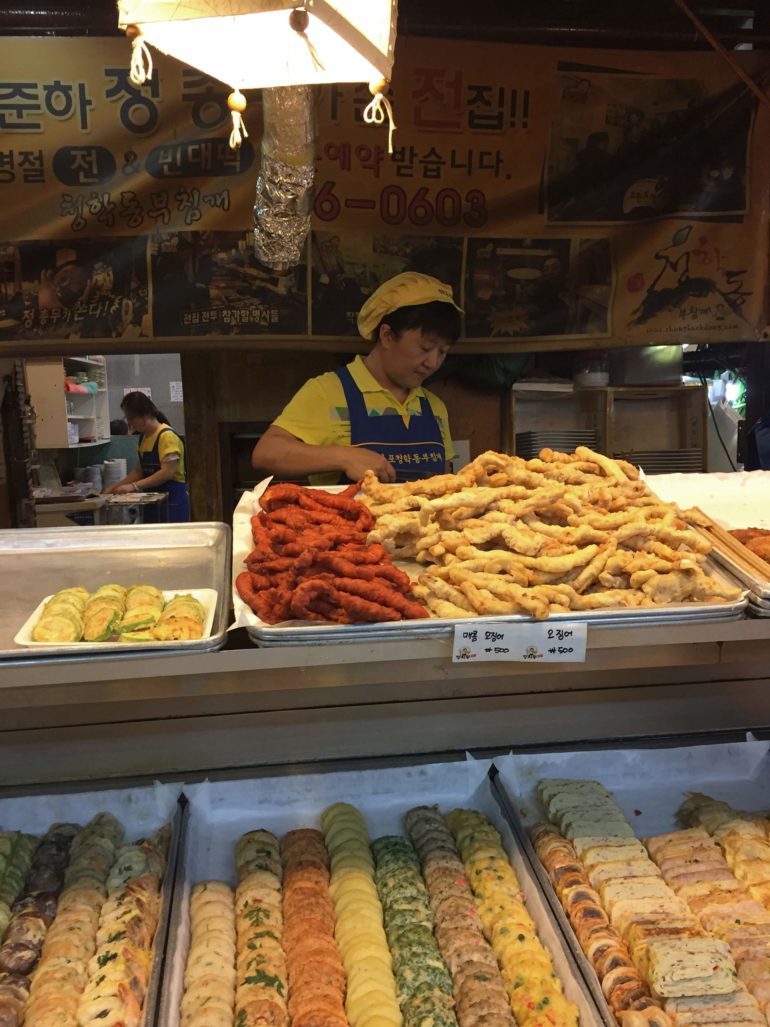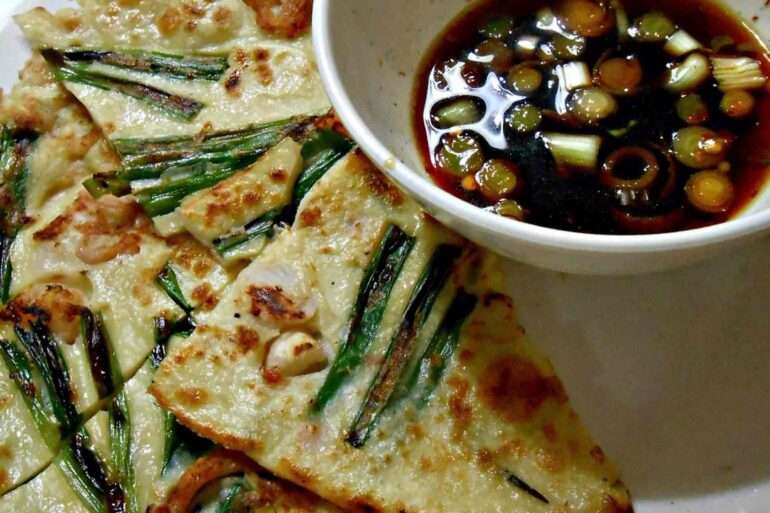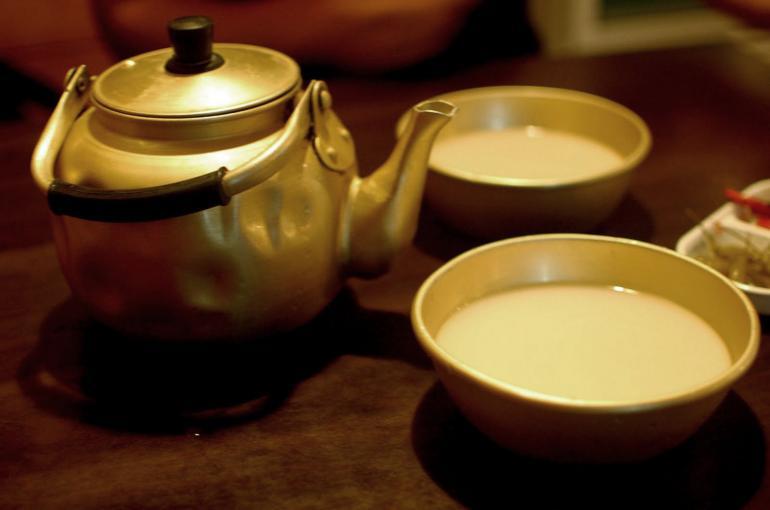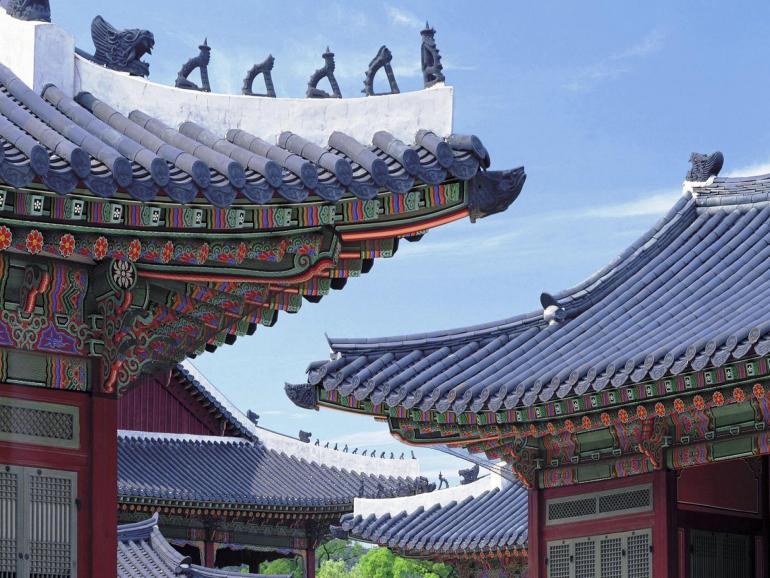We were by now full and well-watered, but Joe still wanted to show us something different and gave us a formal introduction to the other Korean drinking staple (there was a distinct trend forming here), the pajeon (pancake). He led us through the streets of Hongdae, pointing out some quirky things along the way, up a ramshackle alley to an equally noisy eatery, where outside, ladies were hawking everything from soft shell crab to stuffed lotus root, battered and fried. The variety was simply astonishing and the ladies, despite my clear non-comprehension of Hangul, the Korean mother tongue, would present and talk through each different pancake, trying to get me to taste and buy – at least, I assume that was what all the gesticulating was about. Joe indicated that we were actually eating in, and led us up some rickity stairs, to a quaint dining room, where we sat barefoot, cross-legged on a raised floor and awaited the treats to come.
“You’ll be pleased to know that today in Hongdae and Itaewon, you can even find hipster, craft-makgeoli bars.”
Jeon (the Pajeon is the most famous, flavoured with scallions) is typically an anju, or a ‘food to eat while drinking’. There are countless varieties, it seems you can put whatever you want in a rice flour pancake mix, fry it and you’re on your way. Korean pancakes are typically washed down with fermented rice beer, makgeolli which made its way to the table with much fanfare. I was somewhat stuffed from the barbeque, but the makgeolli, I found very interesting and particularly pleasing to my pallate, despite never having tried it before. I discovered from Joe that, originally a poor man’s drink, it has experienced a resurgence in recent years among the Korean middle-classes. Literally meaning ‘roughly strained’, this unfiltered, undistilled rice beer is Korea’s oldest drink, made by peasants in the countryside from nothing more than fermented rice, yeast and water. It’s milky, creamy and somewhat sweet, with a light fizz and from the fermentation process, providing a delightful finish. Apparently it disappeared after the Korean War, right up until after the new millennium and in its place, beer became the drink of choice.
In the noughties, some bright, young spark opened a bar and started marketing makgeolli as a lighter alternative to beer, by promoting its ability to line the stomach like yoghurt, making it a perfect all-night drink. At first, the chattering classes weren’t sold, because they didn’t want to be associated with ‘poor’ Korea – Chardonnay looks better on the table, after all. But technically, it’s actually good for you: 10% of the drink is composed of lactic acid bacteria and dietary fibre. It also contains anti-carcinogenic substances, such as squalene (usually found in fish liver oils) and farnesol. Koreans soon took to it – like selling oil to the Arabs you might say, but that’s the power of marketing. Add a K-pop star as your poster-boy and serve it from a metal bowl rather than glass and it instantly becomes cool. You’ll be pleased to note that today in Hongdae and Itaewon (the expatriate district of Seoul that is home to the American military bases), you can even find hipster, craft-makgeolli bars.
The night took a dangerous turn as we switched the makgeolli for a newly-released and extremely drinkable flavoured soju. Traditionally, soju is a distilled liquor made from rice, sweet potato, tapioca; anything with sugar in, in fact – every culture has a moonshine of some description. Soju can range in alcohol content anywhere from a fortified wine, right up to a vodka (and beyond, I’ve been told) and pretty much guarantees a hangover.
The great thing about Koreans is that they’re not averse to rejigging tradition. Flavoured soju only appeared on the market a year or so ago but has already become a huge commercial success and launched in other varieties including grapefruit, peach and citron – weaker, drinkable and profitable, no doubt. Our shot glasses flowed to the brim, over and over again, amongst calls of ‘Geonbae!’ (‘Cheers’ to us, but ‘dry-glass, already!’ to Koreans), and it dawned on me why they’re such a loud and jolly bunch.
I absolutely loved my evening out with Joe, albeit just the tip of the iceberg when it comes to delving into Korean culinary and drinking culture. There’s so much about Korean food that Joe could tell you, and my night was merely a crash course. From super fine dining to the weird and wonderful, to getting down and dirty in the markets, to the plethora of Korean-fusion places opening up across the capital, merging local tastes with those of American, French and Indian – there is a definite passion for food and drink, both consuming and making.
“For all its madness in appearance, everything comes together with its own distinct purpose to make it magical and memorable.”
My experience with Joe also taught me a lot about the spirit of Seoul beyond the food and drink, and how it varies so much as compared to Tokyo. In Japan, food is presented as an art, each dish has its place, is dressed beautifully and has a story – each savoured slowly and separately. It’s often raw, but mostly delicate and understated – and sometimes it’s served with a little kick of wasabi just to spice things up and keep you on your toes.
In Korea, food culture and real life are both represented by loud, but organised chaos – like a hot bowl of bibimbap, you can’t touch it when it first arrives as it’s hot and sometimes weird; everything is thrown together, layers of ingredients and seasoning arrive on top of each other and mixed up in one melting pot. There are many textures, flavours and there’s a lot of depth. Some elements are centuries old, but others are much more modern and experimental. It’s exciting and addictive – you’ll want more and more of it, but soon the best bits are stuck to the side and you’re dying to scrape it off. But for all its madness in appearance, everything comes together with its own distinct purpose to make it magical and memorable. The flavours are strong and unsubtle, loud in fact – spice laughs heartily at you if you can’t take it, and you’re told to wash it down with booze and try it again – and people are encouraged to jump in, stir it all up, pass it around and enjoy it. I can’t wait to return and taste it all over again.
Joe McPherson is the founder of ZenKimchi, one of Korea’s premier food blogs. ZenKimchi covers Korea’s gastronomic scene and Joe is a local celebrity in the Seoul food and drink scene. His website and social media feeds offer restaurant reviews, recipes and recaps of food adventures. Joe also runs inside-track food walking tours, taking visitors to Seoul beneath the surface of Korean cuisine and providing a personal introduction to Korean culture. We thoroughly recommend booking a night out with him.
Photography by Uwern Jong
Get out there
Do…
… learn this word: ‘Jalmukesumneda’ (I will eat well), to be said before you tuck into a meal. It will either impress or entertain – depending on your pronounciation skills, of course.
… remember it’s impolite to refuse an alcoholic drink from someone you’re dining with, particularly if they are older. Unless you’re driving, what harm can a single drink do? Simply accept and say, ‘Geonbae!”
… forget about your diet for once (we won’t tell!) and try Korean fried chicken, which is something else. Every local has their own favourite, but don’t miss out on this luxurious, deep-fried delight.
Don’t…
… overestimate yourself. If you’re not the adventurous type, head to the basement at any Hyundai department store for the best food court experience. You can mix and match dishes from a choice of 10 eateries.
… just stick to Korean. For something a little different, head to Northern Seoul’s Hyewhadong for some Filipino eats, it’s the best outside the archipelago.
… forget to save some energy for the all-night clothing wholesale market in Dongdaemun – this chaotic market opens at midnight. Alternatively, head to the party district of Itaewon and sample the delights of Homo-hill.
At OutThere, we believe in boundless travel. But we understand that some destinations can pose challenges to travellers that complicate visiting them. We advise all visitors to inform themselves about local legislation and customs, and to work with a trusted travel provider in order to ensure a safe and pleasant holiday.


